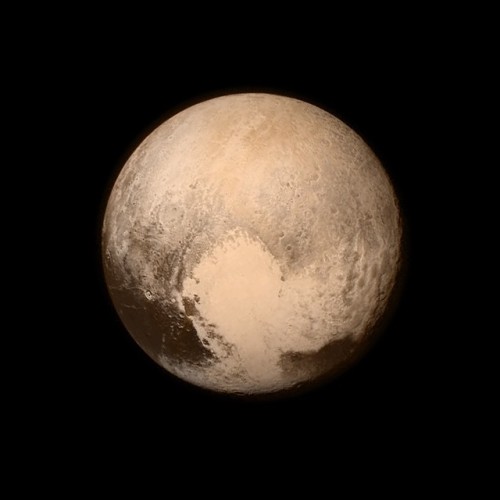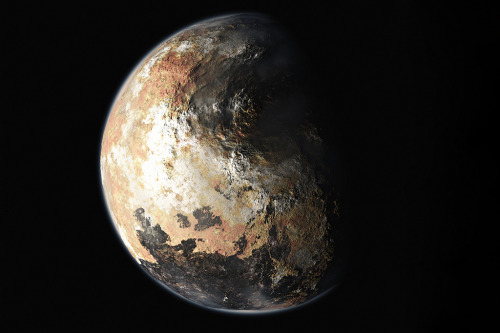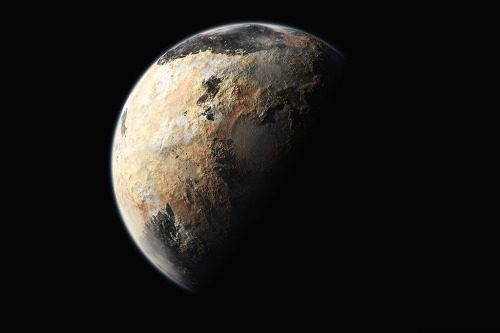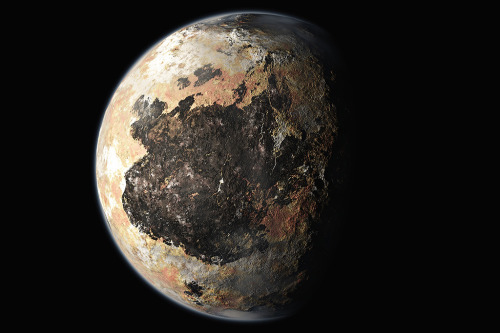Pluto - Blog Posts
See? Pluto! That's how you tell the difference between good and bad solar system art

our pretty void
//pls dont remove caption
And Pluto?

Watercolor solar system: by Shannon Newlin's
Solar System 10 Things: Looking Back at Pluto
In July 2015, we saw Pluto up close for the first time and—after three years of intense study—the surprises keep coming. “It’s clear,” says Jeffery Moore, New Horizons’ geology team lead, “Pluto is one of the most amazing and complex objects in our solar system.”
1. An Improving View

These are combined observations of Pluto over the course of several decades. The first frame is a digital zoom-in on Pluto as it appeared upon its discovery by Clyde Tombaugh in 1930. More frames show of Pluto as seen by the Hubble Space Telescope. The final sequence zooms in to a close-up frame of Pluto taken by our New Horizons spacecraft on July 14, 2015.
2. The Heart

Pluto’s surface sports a remarkable range of subtle colors are enhanced in this view to a rainbow of pale blues, yellows, oranges, and deep reds. Many landforms have their own distinct colors, telling a complex geological and climatological story that scientists have only just begun to decode. The image resolves details and colors on scales as small as 0.8 miles (1.3 kilometers). Zoom in on the full resolution image on a larger screen to fully appreciate the complexity of Pluto’s surface features.
3. The Smiles

July 14, 2015: New Horizons team members Cristina Dalle Ore, Alissa Earle and Rick Binzel react to seeing the spacecraft’s last and sharpest image of Pluto before closest approach.
4. Majestic Mountains

Just 15 minutes after its closest approach to Pluto, the New Horizons spacecraft captured this near-sunset view of the rugged, icy mountains and flat ice plains extending to Pluto’s horizon. The backlighting highlights more than a dozen layers of haze in Pluto’s tenuous atmosphere. The image was taken from a distance of 11,000 miles (18,000 kilometers) to Pluto; the scene is 780 miles (1,250 kilometers) wide.
5. Icy Dunes

Found near the mountains that encircle Pluto’s Sputnik Planitia plain, newly discovered ridges appear to have formed out of particles of methane ice as small as grains of sand, arranged into dunes by wind from the nearby mountains.
6. Glacial Plains

The vast nitrogen ice plains of Pluto’s Sputnik Planitia – the western half of Pluto’s “heart”—continue to give up secrets. Scientists processed images of Sputnik Planitia to bring out intricate, never-before-seen patterns in the surface textures of these glacial plains.
7. Colorful and Violent Charon

High resolution images of Pluto’s largest moon, Charon, show a surprisingly complex and violent history. Scientists expected Charon to be a monotonous, crater-battered world; instead, they found a landscape covered with mountains, canyons, landslides, surface-color variations and more.
8. Ice Volcanoes

One of two potential cryovolcanoes spotted on the surface of Pluto by the New Horizons spacecraft. This feature, known as Wright Mons, was informally named by the New Horizons team in honor of the Wright brothers. At about 90 miles (150 kilometers) across and 2.5 miles (4 kilometers) high, this feature is enormous. If it is in fact an ice volcano, as suspected, it would be the largest such feature discovered in the outer solar system.
9. Blue Rays

Pluto’s receding crescent as seen by New Horizons at a distance of 120,000 miles (200,000 kilometers). Scientists believe the spectacular blue haze is a photochemical smog resulting from the action of sunlight on methane and other molecules in Pluto’s atmosphere. These hydrocarbons accumulate into small haze particles, which scatter blue sunlight—the same process that can make haze appear bluish on Earth.
10. Encore

On Jan. 1, 2019, New Horizons will fly past a small Kuiper Belt Object named MU69 (nicknamed Ultima Thule)—a billion miles (1.5 billion kilometers) beyond Pluto and more than four billion miles (6.5 billion kilometers) from Earth. It will be the most distant encounter of an object in history—so far—and the second time New Horizons has revealed never-before-seen landscapes.
Make sure to follow us on Tumblr for your regular dose of space: http://nasa.tumblr.com.

Pluto ‘Paints’ its Largest Moon Red
In June 2015, when the cameras on NASA’s approaching New Horizons spacecraft first spotted the large reddish polar region on Pluto’s largest moon, Charon, mission scientists knew two things: they’d never seen anything like it elsewhere in our solar system, and they couldn’t wait to get the story behind it.
Over the past year, after analyzing the images and other data that New Horizons has sent back from its historic July 2015 flight through the Pluto system, the scientists think they’ve solved the mystery. As they detail this week in the international scientific journal Nature, Charon’s polar coloring comes from Pluto itself – as methane gas that escapes from Pluto’s atmosphere and becomes “trapped” by the moon’s gravity and freezes to the cold, icy surface at Charon’s pole. This is followed by chemical processing by ultraviolet light from the sun that transforms the methane into heavier hydrocarbons and eventually into reddish organic materials called tholins.
"Who would have thought that Pluto is a graffiti artist, spray-painting its companion with a reddish stain that covers an area the size of New Mexico?" asked Will Grundy, a New Horizons co-investigator from Lowell Observatory in Flagstaff, Arizona, and lead author of the paper. "Every time we explore, we find surprises. Nature is amazingly inventive in using the basic laws of physics and chemistry to create spectacular landscapes."
The team combined analyses from detailed Charon images obtained by New Horizons with computer models of how ice evolves on Charon’s poles. Mission scientists had previously speculated that methane from Pluto’s atmosphere was trapped in Charon’s north pole and slowly converted into the reddish material, but had no models to support that theory.
The New Horizons team dug into the data to determine whether conditions on the Texas-sized moon (with a diameter of 753 miles or 1,212 kilometers) could allow the capture and processing of methane gas. The models using Pluto and Charon’s 248-year orbit around the sun show some extreme weather at Charon’s poles, where 100 years of continuous sunlight alternate with another century of continuous darkness. Surface temperatures during these long winters dip to -430 Fahrenheit (-257 Celsius), cold enough to freeze methane gas into a solid.
“The methane molecules bounce around on Charon's surface until they either escape back into space or land on the cold pole, where they freeze solid, forming a thin coating of methane ice that lasts until sunlight comes back in the spring,” Grundy said. But while the methane ice quickly sublimates away, the heavier hydrocarbons created from it remain on the surface.
The models also suggested that in Charon’s springtime the returning sunlight triggers conversion of the frozen methane back into gas. But while the methane ice quickly sublimates away, the heavier hydrocarbons created from this evaporative process remain on the surface.
Sunlight further irradiates those leftovers into reddish material – called tholins – that has slowly accumulated on Charon’s poles over millions of years. New Horizons’ observations of Charon’s other pole, currently in winter darkness – and seen by New Horizons only by light reflecting from Pluto, or “Pluto-shine” – confirmed that the same activity was occurring at both poles.
“This study solves one of the greatest mysteries we found on Charon, Pluto’s giant moon,” said Alan Stern, New Horizons principal investigator from the Southwest Research Institute, and a study co-author. “And it opens up the possibility that other small planets in the Kuiper Belt with moons may create similar, or even more extensive ‘atmospheric transfer’ features on their moons.”
Credits: NASA/JHUAPL/SwRI
Solar System: Things to Know This Week
Our solar system is huge, let us break it down for you. Here are a few things to know this week:
1. The View from the Far Shore

The rugged shores of Pluto’s highlands come into sharp view in a newly released image from our New Horizons spacecraft. This latest view zooms in on the southeastern portion of Pluto’s great ice plains, where they border dark highlands formerly named Krun Macula.
2. Dawn’s Latest Light

Our Dawn mission has now completed more than 1,000 orbital revolutions since entering into Ceres’ gravitational grip in March 2015. The probe is healthy and performing its ambitious assignments impeccably. See what it has revealed lately HERE.
3. Counting Down

Our OSIRIS-REx mission to the asteroid Bennu is now entering the final preparations for its planned launch in September. In a new interview, the mission’s principal investigator reports on the final pre-flight tests happening at our Kennedy Space Center in Florida.
4. Deep Dive

Three successful engine maneuvers to bring the lowest part of the spacecraft’s orbit down to just 74 miles (119 km) above the surface of Mars, the MAVEN mission’s fifth deep dip campaign has begun. MAVEN is studying the planet’s atmosphere up close.
5. Storm Season

Meanwhile, other robotic Mars orbiters have revealed that a pattern of three large regional dust storms occurs with similar timing most Martian years. The seasonal pattern was detected from dust storms’ effects on atmospheric temperatures, which spacecraft have been monitoring since 1997.
Want to learn more? Read our full list of the 10 things to know this week about the solar system HERE.
Make sure to follow us on Tumblr for your regular dose of space: http://nasa.tumblr.com

Pluto’s twilight zone
NASA’s New Horizons spacecraft took this stunning image of Pluto only a few minutes after closest approach on July 14, 2015. The image was obtained at a high phase angle –that is, with the sun on the other side of Pluto, as viewed by New Horizons. Seen here, sunlight filters through and illuminates Pluto’s complex atmospheric haze layers. The southern portions of the nitrogen ice plains informally named Sputnik Planum, as well as mountains of the informally named Norgay Montes, can also be seen across Pluto’s crescent at the top of the image.
Credit: NASA/JHUAPL/SwRI
To all my space loving followers: Nasa finally got Tumblr so go ahead and follow them!
Solar System: Top 5 Things to Know This Week
It’s only Tuesday and this week is already filled with news about our solar system. Here are the top five things to know this week:
1) Mars!

With five spacecraft in orbit and two rovers exploring the ground, there’s always something new and interesting about the Red Planet. Yesterday things got even more exciting when we released the most compelling evidence yet that liquid water sometimes flows on Mars today.
2) HTV-5 Cargo Ship

On Monday, the HTV-5 cargo ship was released from the International Space Station to burn up as it reenters Earth’s atmosphere. The HTV-5 carried a variety of experiments and supplies to the space station, and was docked for five weeks.
3) Pluto Continues to Excite

If you haven’t been keeping up with the weekly releases of newly downloaded pictures from our New Horizons spacecraft, you are definitely missing out. But don’t worry, we have you covered. The latest updates can be found HERE, be sure to follow along as new information is released. More images are scheduled to be featured on Oct. 1.
4) Cassini Mission

This week on Sept. 30, our Cassini spacecraft will reach the closest point to Saturn in it’s latest orbit around the planet. Just to put things in perspective, that will be Cassini’s 222nd orbit around Saturn! Learn more about this mission HERE.
5) What Happened to Mars’ Atmosphere?

Believe it or not, the Martian atmosphere we see today used to be much more substantial many years ago. What happened? Our Mars Atmosphere and Volatile EvolutioN (MAVEN) spacecraft has been in orbit around Mars for one Earth year, searching for the answers. Learn more HERE.
Make sure to follow us on Tumblr for your regular dose of space:http://nasa.tumblr.com
Where's the daughter of Neptune, Rick?
Like, seriously, where is she?
All the Big Three have at least two kids, one Greek and one Roman, one male and one female.
Zeus has Thalia, his Greek kid who emulates his lightning, and Jupiter has Jason, his Roman son who channels the winds.
Hades has Nico, who is the stereotypical Greek son of the lord of the dead, and Pluto has Hazel, his Roman kid who reminds demigods that he is the god of riches too.
Poseidon has Percy, his great demigod son who is just like the sea.
Where is Neptune's daughter, the child of the Earthshaker, who makes the ground quake when she's mad? Where is the girl who has a greater affinity with horses than even Percy or Hazel, who wins any horse race she participates in? Where is the demigoddess who is so much more comfortable in a lake than in the sea, because Romans associated Neptune with freshwater more than the sea? The girl that the legionnaires always blame when a fresh drought comes in, who's shunned because Neptune's kids are considered dangerous to have around, who understands Nico di Angelo on a level that the Greeks don't get, because she's considered bad luck too? The girl that immediately volunteered to go with Jason Grace when he quested to kill the Trojan Sea Monster, because he didn't know the ocean like she did?
Where is she, Rick?








The Science Has Spoken: Pluto Will Never Be A Planet Again
“What’s perhaps most remarkable is that we can make a simple, mathematical relationship between a world’s mass and its orbital distance that can be scaled and applied to any star. If you’re above these lines, you’re a planet; if you’re below it, you’re not. Note that even the most massive dwarf planets would have to be closer to the Sun than Mercury is to reach planetary status. Note by how fantastically much each of our eight planets meets these criteria… and by how much all others miss it. And note that if you replaced the Earth with the Moon, it would barely make it as a planet.”
It was a harsh lesson in astronomy for all of us in 2006, when the International Astronomical Union released their official definition of a planet. While the innermost eight planets made the cut, Pluto did not. But given the discovery of large numbers of worlds in the Kuiper belt and beyond our Solar System, it became clear that we needed something even more than what the IAU gave us. We needed a way to look at any orbiting worlds around any star and determine whether they met a set of objective criteria for reaching planetary status. Recently, Alan Stern spoke up and introduced a geophysical definition of a planet, which would admit more than 100 members in our Solar System alone. But how does this stand up to what astronomers need to know?
As it turns out, not very well. But the IAU definition needs improving, too, and modern science is more than up to the challenge. See who does and doesn’t make the cut into true planetary status, and whether Planet Nine – if real – will make it, too!



Time for another comic on our reddish dwarf planet, Makemake!
(Polaris is pushed for tomorrow ;) )
http://www.space.com/23122-makemake.html



Another Saturday morning comic!
This week’s entry: Meet Eris
http://www.space.com/28379-eris-dwarf-planet.html
http://www.universetoday.com/89901/pluto-or-eris-which-is-bigger/



Photos of space are everywhere online. Their beauty is dazzling, showing a universe awash in color and light. But if you’re a skeptic, you’ve likely wondered whether it all truly looks like that in real life. Michael Benson took data from NASA and ESA missions to make 77 images of everything from Pluto to Europa. In his exhibition Otherworlds: Visions of Our Solar System, Benson tries his best to create images that represent what a moon or planet might actually look like if you could peer at it out a spaceship window. Check out more photos and read about Benson’s project.


And here they are! The first hi resolution images released by NASA from yesterday’s flawless flyby of Pluto.
The close-up is a view of a region on Pluto at the bottom of ‘the heart’, the feature seen on the pre-approach image posted on July 14, yesterday, at 7:23 am. It reveals a smooth area in the upper left, a hummocky region in the lower right, and in between mountains that are 11,000 feet high! The only material on Pluto that is strong enough to build mountains is water ice. The other volatiles, nitrogen and methane, which are escaping Pluto as vapor, are apparently no more than a thin veneer. This image has a resolution of ~ 1 mile/pixel.
The other image is Pluto’s largest moon, Charon, about ½ the size of Pluto, seen at an image scale of ~ 3 miles/pixel. It surprises in several ways: a long chasm reminiscent of Saturn’s moon Tethys, a variable surface appearance, and very few craters that indicate a relatively youthful surface.
How mind-blowing it is that we are today discussing processes operating at 32x farther from the Sun than is the Earth, and over 3x farther away than Saturn. And yesterday, it was just a dream.
Think about that! CICLOPS.org: The Icy Mountains of Pluto CICLOPS.org: Charon’s Surprising Youthful and Varied Terrain






NASA Co-Op Week 17: First Co-Op Tour Wrap Up
During my final week at NASA this fall I leave PLUTO with a helpful tool. I am putting together a database of hardware on board the International Space Station that is searchable by part number or name. Sometimes the astronauts ask about something that is hard to explain and visualize so this will ease communication. This may not be the most technical task but I wanted to leave them with a really helpful tool. This week I am also awaiting the opportunity to watch the astronauts use my training.
I have thoroughly enjoyed my semester with PLUTO. My top three experiences would have to be developing the astronaut training, visiting Kennedy Space Center and sitting console in Mission Control. PLUTO's work environment is impressive with friendly people, personal growth opportunities and approachable leaders. The PLUTO team was so gracious to nominate and present to me a Co-Op award for my work this semester. It is such an honor to work with these passionate and talented Mission Control specialists. This summer I return to the Co-Op program with the Propulsion and Power Division turning Moon and Mars regolith into fuel. I am so thankful for my Co-Op opportunity and I hope you all can get involved with NASA too! Please check out ways you can be a part of the NASA mission below.
WAYS TO GET INVOLVED
Apply for a NASA Internship NOW (high school to grad school):
https://intern.nasa.gov/ossi/web/public/main/
Apply for a NASA Co-Op (Pathways Internship):
http://nasajobs.nasa.gov/studentopps/employment/opportunities.htm
Other current NASA opportunities for students:
http://www.nasa.gov/audience/forstudents/current-opps-index.html
Apply to be a NASA astronaut due Feb 18th:
https://www.usajobs.gov/GetJob/ViewDetails/423817000
Follow Scott Kelly in his yearlong mission: http://time.com/space-nasa-scott-kelly-mission/




NASA Co-Op Week 3: Sitting Console
A scene from the New York stock exchange center was what I expected from Mission Control. Imagining the flight director with a thick cigar and eyebrows raised, flight controllers sitting console arguing about an experiment or device gone haywire and astronauts happily floating and Tweeting hearing only commands from Cap-Com that got through. My expectation was fortunately far from the truth.
Mission Control is calm, controlled and direct. The flight director welcomes the console leads, PLUTO, Ops Plan, RIO, ROBO, ISO and so on. Each flight controller checks in with a status and their goals to accomplish. Astronauts join in every morning for a daily operations meeting asking questions about upcoming experiments and big ticket events. Cap-Com is the only position in Mission Control that speaks with the astronauts so other flight controllers let Cap-Com know what needs to be relayed to astronauts. While sitting console with PLUTO I could listen to all the audio loops, Russian translation loop, JAXA, ESA, each console, and other NASA centers.
HOW TO GET INVOLVED:
*Tour the Mission Control Center through Space Center Houston
*Apply for a Pathways Internship (Co-Op) NOW ONLY OPEN SEP 14-18 for Johnson Space Center
*Apply for an internship at one of the many NASA centers.
*Follow NASA on Tumblr







NASA Co-Op Week 1: Mission Control
What Am I Doing?!
For my first post as a NASA Co-Op I’m going to skip the typical “Houston we have a problem” and “All systems go” intro and get right to the good stuff. I just completed my first week as a NASA Pathways Intern at Johnson Space Center, what NASA calls their Co-Op program. I will be flip-flopping between working at NASA and my university studying Electrical Engineering until I graduate. 98% of students get hired on full-time with NASA after a successful Co-Op experience. This fall 16 out of over 1000 applicants are Co-Oping this fall. I am thankful to be working alongside such talented and passionate people.
Flying The Space Station
I am “touring”, what we call our Co-Op work tours, in a team in Mission Control called PLUTO. No, I am not working with New Horizons, PLUTO is in charge of the Plug and Play-Ability of hardware and software on the International Space Station (ISS). I will be helping develop technology that assist astronauts in experimenting in space, writing procedures for astronauts and sitting console in Mission Control. I can’t rent a car without an extra fee but I can help fly the multi-billion dollar ISS, makes sense.
How To Get Involved
Follow my weekly posts for the Co-Op perspective, Follow NASA on Tumblr, watch what NASA is up to, and apply for an internship or Co-Op with NASA.

Good morning America and the whole wide world. Here is Pluto! Congratulations to New Horizon’s crew for their hard work and dedication. So inspiring that some of those on the mission have been with it since they were undergraduates in college! At 9pmET we get the first “phone home” pings from New Horizons on its mission status. Then for the next 16 months we get a waterfall of data from Pluto. Watch here: http://www.nasa.gov/multimedia/nasatv/
Watch NASA's NewHorizons Pluto Flyby TOMORROW Tuesday July 14th 6:30-7:30amCT on NASA TV


These slides, presented during the New Horizons’ press conference at the 47th Lunar and Planetary Science Conference, show the climate zones of Pluto compared to Earth. Pluto has an axial tilt of 120°, which creates extreme tropic and arctic regions. The two regions overlap, creating a ‘tropical arctic’ region that experiences both direct sunlight and prolonged sunlight and darkness. At the moment, Pluto is in an intermediate state between the extreme tropic and arctic climates.
Image Credit: NASA/Johns Hopkins University Applied Physics Laboratory/Southwest Research Institute

Pluto and Proserpine by Edward James Physick (1849)

![[Link]](https://64.media.tumblr.com/8ef69df975410776fc3094d07fa9f089/d61b40f8461ef78d-a7/s1280x1920/642eff5abf526b8e64b9d1e97c203fbcbe1349cd.png)












